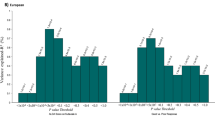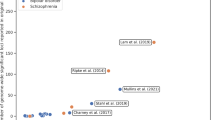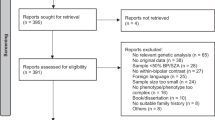Abstract
The FKBP5 gene product forms part of a complex with the glucocorticoid receptor and can modulate cortisol-binding affinity. Variations in the gene have been associated with increased recurrence of depression and with rapid response to antidepressant treatment. We sought to determine whether common FKBP5 variants confer risk for bipolar disorder. We genotyped seven tag single-nucleotide polymorphisms (SNPs) in FKBP5, plus two SNPs previously associated with illness, in 317 families with 554 bipolar offspring, derived primarily from two studies. Single marker and haplotypic analyses were carried out with FBAT and EATDT employing the standard bipolar phenotype. Association analyses were also conducted using 11 disease-related variables as covariates. Under an additive genetic model, rs4713902 showed significant overtransmission of the major allele (P=0.0001), which was consistent across the two sample sets (P=0.004 and 0.006). rs7757037 showed evidence of association that was strongest under the dominant model (P=0.001). This result was consistent across the two datasets (P=0.017 and 0.019). The dominant model yielded modest evidence for association (P<0.05) for three additional markers. Covariate-based analyses suggested that genetic variation within FKBP5 may influence attempted suicide and number of depressive episodes in bipolar subjects. Our results are consistent with the well-established relationship between the hypothalamic–pituitary–adrenal (HPA) axis, which mediates the stress response through regulation of cortisol, and mood disorders. Ongoing whole-genome association studies in bipolar disorder and major depression should further clarify the role of FKBP5 and other HPA genes in these illnesses.
This is a preview of subscription content, access via your institution
Access options
Subscribe to this journal
Receive 12 print issues and online access
$259.00 per year
only $21.58 per issue
Buy this article
- Purchase on Springer Link
- Instant access to full article PDF
Prices may be subject to local taxes which are calculated during checkout

Similar content being viewed by others
References
Kessler RC, Akiskal HS, Angst J, Guyer M, Hirschfeld RM, Merikangas KR et al. Validity of the assessment of bipolar spectrum disorders in the WHO CIDI 3.0. J Affect Disord 2006; 96: 259–269.
Smoller JW, Finn CT . Family, twin, and adoption studies of bipolar disorder. Am J Med Genet 2003; 123C: 48–58.
Board F, Persky H, Hamburg DA . Psychological stress and endocrine functions; blood levels of adrenocortical and thyroid hormones in acutely disturbed patients. Psychosom Med 1956; 18: 324–333.
Board F, Wadeson R, Persky H . Depressive affect and endocrine functions; blood levels of adrenal cortex and thyroid hormones in patients suffering from depressive reactions. AMA Arch Neurol Psychiatry 1957; 78: 612–620.
Carroll BJ, Martin FI, Davies B . Resistance to suppression by dexamethasone of plasma 11-O.H.C.S. levels in severe depressive illness. Br Med J 1968; 3: 285–287.
Nelson JC, Davis JM . DST studies in psychotic depression: a meta-analysis. Am J Psychiatry 1997; 154: 1497–1503.
Heuser I, Yassouridis A, Holsboer F . The combined dexamethasone/CRH test: a refined laboratory test for psychiatric disorders. J Psychiatr Res 1994; 28: 341–356.
Rybakowski JK, Twardowska K . The dexamethasone/corticotropin-releasing hormone test in depression in bipolar and unipolar affective illness. J Psychiatr Res 1999; 33: 363–370.
Watson S, Gallagher P, Ritchie JC, Ferrier IN, Young AH . Hypothalamic-pituitary-adrenal axis function in patients with bipolar disorder. Br J Psychiatry 2004; 184: 496–502.
Mannie ZN, Harmer CJ, Cowen PJ . Increased waking salivary cortisol levels in young people at familial risk of depression. Am J Psychiatry 2007; 164: 617–621.
Ellenbogen MA, Hodgins S, Walker CD, Couture S, Adam S . Daytime cortisol and stress reactivity in the offspring of parents with bipolar disorder. Psychoneuroendocrinology 2006; 31: 1164–1180.
Holsboer F, Lauer CJ, Schreiber W, Krieg JC . Altered hypothalamic-pituitary-adrenocortical regulation in healthy subjects at high familial risk for affective disorders. Neuroendocrinology 1995; 62: 340–347.
Modell S, Lauer CJ, Schreiber W, Huber J, Krieg JC, Holsboer F . Hormonal response pattern in the combined DEX-CRH test is stable over time in subjects at high familial risk for affective disorders. Neuropsychopharmacology 1998; 18: 253–262.
van Rossum EF, Binder EB, Majer M, Koper JW, Ising M, Modell S et al. Polymorphisms of the glucocorticoid receptor gene and major depression. Biol Psychiatry 2006; 59: 681–688.
van West D, Van Den EF, Del Favero J, Souery D, Norrback KF, Van Duijn C et al. Glucocorticoid receptor gene-based SNP analysis in patients with recurrent major depression. Neuropsychopharmacology 2006; 31: 620–627.
Binder EB, Salyakina D, Lichtner P, Wochnik GM, Ising M, Putz B et al. Polymorphisms in FKBP5 are associated with increased recurrence of depressive episodes and rapid response to antidepressant treatment. Nat Genet 2004; 36: 1319–1325.
Reynolds PD, Ruan Y, Smith DF, Scammell JG . Glucocorticoid resistance in the squirrel monkey is associated with overexpression of the immunophilin FKBP51. J Clin Endocrinol Metab 1999; 84: 663–669.
McQuillin A, Rizig M, Gurling H . A microarray gene expression study of the effects lithium carbonate on mouse brain mRNA in order to understand the neurobiology of mood stabilisation and treatment of bipolar affective disorder. Pharmacogenetic Genomics 2007; 17: 605–617.
McInnis MG, Lan TH, Willour VL, McMahon FJ, Simpson SG, Addington AM et al. Genome-wide scan of bipolar disorder in 65 pedigrees: supportive evidence for linkage at 8q24, 18q22, 4q32, 2p12, and 13q12. Mol Psychiatry 2003; 8: 288–298.
Detera-Wadleigh SD, Badner JA, Berrettini WH, Yoshikawa T, Goldin LR, Turner G et al. A high-density genome scan detects evidence for a bipolar-disorder susceptibility locus on 13q32 and other potential loci on 1q32 and 18p11.2. Proc Natl Acad Sci USA 1999; 96: 5604–5609.
NIMH Genetics Initiative Bipolar Group. Genomic survey of bipolar illness in the NIMH genetics initiative pedigrees: a preliminary report. Am J Med Genet 1997; 74: 227–237.
Endicott J, Spitzer RL . A diagnostic interview: the schedule for affective disorders and schizophrenia. Arch Gen Psychiatry 1978; 35: 837–844.
Spitzer RL, Endicott J . Research Diagnostic Criteria (RDC) for a Selected Group of Functional Disorders. New York State Psychiatric Institute, Biometrics Research, 1975.
Nurnberger JIJ, Blehar MC, Kaufmann CA, York-Cooler C, Simpson SG, Harkavy-Friedman J et al. Diagnostic interview for genetic studies. Rationale, unique features, and training. NIMH Genetics Initiative. Arch Gen Psychiatry 1994; 51: 849–859.
Potash JB, Toolan J, Steele J, Miller EB, Pearl J, Zandi PP et al. The bipolar disorder phenome database: a resource for genetic studies. Am J Psychiatry 2007; 164: 1229–1237.
International HapMap Consortium. A haplotype map of the human genome. Nature 2005; 437: 1299–1320.
Carlson CS, Eberle MA, Rieder MJ, Yi Q, Kruglyak L, Nickerson DA . Selecting a maximally informative set of single-nucleotide polymorphisms for association analyses using linkage disequilibrium. Am J Hum Genet 2004; 74: 106–120.
Oliphant A, Barker DL, Stuelpnagel JR, Chee MS . BeadArray technology: enabling an accurate, cost-effective approach to high-throughput genotyping. Biotechniques 2002; 56–58 (Suppl): 60–61.
Livak KJ . Allelic discrimination using fluorogenic probes and the 5′ nuclease assay. Genet Anal 1999; 14: 143–149.
Barrett JC, Fry B, Maller J, Daly MJ . Haploview: analysis and visualization of LD and haplotype maps. Bioinformatics 2005; 21: 263–265.
Rabinowitz D, Laird N . A unified approach to adjusting association tests for population admixture with arbitrary pedigree structure and arbitrary missing marker information. Hum Hered 2000; 50: 211–223.
Gabriel SB, Schaffner SF, Nguyen H, Moore JM, Roy J, Blumenstiel B et al. The structure of haplotype blocks in the human genome. Science 2002; 296: 2225–2229.
Lin S, Chakravarti A, Cutler DJ . Exhaustive allelic transmission disequilibrium tests as a new approach to genome-wide association studies. Nat Genet 2004; 36: 1181–1188.
Siepel A, Bejerano G, Pedersen JS, Hinrichs AS, Hou M, Rosenbloom K et al. Evolutionarily conserved elements in vertebrate, insect, worm, and yeast genomes. Genome Res 2005; 15: 1034–1050.
King DC, Taylor J, Elnitski L, Chiaromonte F, Miller W, Hardison RC . Evaluation of regulatory potential and conservation scores for detecting cis-regulatory modules in aligned mammalian genome sequences. Genome Res 2005; 15: 1051–1060.
Gawlik M, Moller-Ehrlich K, Mende M, Jovnerovski M, Jung S, Jabs B et al. Is FKBP5 a genetic marker of affective psychosis? A case control study and analysis of disease related traits. BMC Psychiatry 2006; 6: 52.
Fallin MD, Lasseter VK, Avramopoulos D, Nicodemus KK, Wolyniec PS, McGrath JA et al. Bipolar I disorder and schizophrenia: A 440-single-nucleotide polymorphism screen of 64 candidate genes among Ashkenazi Jewish case-parent trios. Am J Hum Genet 2005; 77: 918–936.
Mitchell AA, Cutler DJ, Chakravarti A . Undetected genotyping errors cause apparent overtransmission of common alleles in the transmission/disequilibrium test. Am J Hum Genet 2003; 72: 598–610.
Baum AE, Akula N, Cabanero M, Cardona I, Corona W, Klemens B et al. A genome-wide association study implicates diacylglycerol kinase eta (DGKH) and several other genes in the etiology of bipolar disorder. Mol Psychiatry 2007; May 8 [e-pub ahead of print].
Wellcome Trust Case-Control Consortium. Genome-wide association study of 14 000 cases of seven common diseases and 3000 shared controls. Nature 2007; 447: 661–678.
Goodwin FK, Jamison KR . Manic-Depressive Illness, Second Edition. Oxford University Press: New York, 2007, pp 126.
Altshuler LL, Post RM, Leverich GS, Mikalauskas K, Rosoff A, Ackerman L . Antidepressant-induced mania and cycle acceleration: a controversy revisited. Am J Psychiatry 1995; 152: 1130–1138.
Acknowledgements
This work was supported by grants from the National Institute of Mental Health (R01 MH-042243 and R01 MH-061613), the Charles A Dana Foundation Consortium on the Genetic Basis of Manic Depressive Illness, the National Alliance for Research on Schizophrenia and Depression, the Alex Brown Foundation and the Stanley Medical Research Institute. Dr Willour and Dr Potash were also supported by Margaret Ann Price Investigatorships. Some DNA samples were prepared and distributed by Rutgers University under a contract from the NIMH. We are grateful to Yuqing Huo, Kuangyi Miao and Brandie Craighead for their contributions. We are also grateful to the many interviewers and diagnosticians who contributed to this project, and to the families who devoted their time and effort to the study.
Author information
Authors and Affiliations
Consortia
Corresponding author
Additional information
The Bipolar Disorder Phenome Group consists of Francis McMahon, Jo Steele, Justin Pearl, Layla Kassem, Victor Lopez from the Genetic Basis of Mood and Anxiety Disorders Unit, Mood and Anxiety Program, National Institute of Mental Health, National Institutes of Health, Bethesda, MD; James Potash, Dean MacKinnon, Erin Miller, Jennifer Toolan from the Department of Psychiatry, Johns Hopkins School of Medicine, Baltimore, MD; Peter Zandi from the Department of Mental Health, Johns Hopkins Bloomberg School of Public Health, Baltimore, MD; Thomas Schulze from the Division of Genetic Epidemiology in Psychiatry, Central Institute of Mental Health, Ruprecht-Karls-University of Heidelberg, Mannheim, Germany; Evaristus Nwulia from the Department of Psychiatry, Howard University Hospital, Washington, DC; Sylvia Simpson from the Department of Psychiatry, University of Colorado at Denver, Denver, CO.
Some of the data and biomaterials were collected in four projects that participated in the NIMH Bipolar Disorder Genetics Initiative from 1991–1998. The Principal Investigators and Co-Investigators were Indiana University, Indianapolis, IN, U01 MH46282, John Nurnberger, MD, PhD, Marvin Miller, MD and Elizabeth Bowman, MD; Washington University, St Louis, MO, U01 MH46280, Theodore Reich, MD, Allison Goate, PhD and John Rice, PhD; Johns Hopkins University, Baltimore, MD U01 MH46274, J Raymond DePaulo, Jr, MD, Sylvia Simpson, MD, MPH and Colin Stine, PhD; NIMH Intramural Research Program, Clinical Neurogenetics Branch, Bethesda, MD, Elliot Gershon, MD, Diane Kazuba, BA and Elizabeth Maxwell, MSW. Other data and biomaterials were collected in 10 NIMH Bipolar Disorder Genetics Initiative projects from 1999–2003. The Principal Investigators and Co-Investigators were Indiana University, Indianapolis, IN, R01 MH59545, John Nurnberger, MD, PhD, Marvin J Miller, MD, Elizabeth S Bowman, MD, N Leela Rau, MD, P Ryan Moe, MD, Nalini Samavedy, MD, Rif El-Mallakh, MD (at University of Louisville), Husseini Manji, MD (at Wayne State University), Debra A Glitz, MD (at Wayne State University), Eric T Meyer, MS, Carrie Smiley, RN, Tatiana Foroud, PhD, Leah Flury, MS, Danielle M Dick, PhD, Howard Edenberg, PhD; Washington University, St Louis, MO, R01 MH059534, John Rice, PhD, Theodore Reich, MD, Allison Goate, PhD, Laura Bierut, MD; Johns Hopkins University, Baltimore, MD, R01 MH59533, Melvin McInnis MD, J. Raymond DePaulo, Jr, MD, Dean F MacKinnon, MD, Francis M Mondimore, MD, James B Potash, MD, Peter P Zandi, PhD, Dimitrios Avramopoulos, PhD and Jennifer Payne, MD; University of Pennsylvania, PA, R01 MH59553, Wade Berrettini MD, PhD; University of California at Irvine, CA, R01 MH60068, William Byerley MD and Mark Vawter MD; University of Iowa, IA, R01 MH059548, William Coryell MD and Raymond Crowe MD; University of Chicago, IL, R01 MH59535, Elliot Gershon, MD, Judith Badner PhD, Francis McMahon MD, Chunyu Liu PhD, Alan Sanders MD, Maria Caserta, Steven Dinwiddie MD, Tu Nguyen, Donna Harakal; University of California at San Diego, CA, R01 MH59567, John Kelsoe, MD, Rebecca McKinney, BA; Rush University, IL, R01 MH059556, William Scheftner MD, Howard M Kravitz, DO, MPH, Diana Marta, BS, Annette Vaughn-Brown, MSN, RN and Laurie Bederow, MA; NIMH Intramural Research Program, Bethesda, MD, 1Z01MH002810-01, Francis J McMahon, MD, Layla Kassem, PsyD, Sevilla Detera-Wadleigh, PhD, Lisa Austin, PhD, Dennis L Murphy, MD.
Rights and permissions
About this article
Cite this article
Willour, V., Chen, H., Toolan, J. et al. Family-based association of FKBP5 in bipolar disorder. Mol Psychiatry 14, 261–268 (2009). https://doi.org/10.1038/sj.mp.4002141
Received:
Revised:
Accepted:
Published:
Issue Date:
DOI: https://doi.org/10.1038/sj.mp.4002141
Keywords
This article is cited by
-
Proteins associated with future suicide attempts in bipolar disorder: A large-scale biomarker discovery study
Molecular Psychiatry (2022)
-
Circulating insulin-like growth factor I modulates mood and is a biomarker of vulnerability to stress: from mouse to man
Translational Psychiatry (2018)
-
Hypothalamic-pituitary-adrenal axis variants and childhood trauma influence anxiety sensitivity in South African adolescents
Metabolic Brain Disease (2018)
-
The emerging role of the FKBP5 gene polymorphisms in vulnerability–stress model of schizophrenia: further evidence from a Serbian population
European Archives of Psychiatry and Clinical Neuroscience (2017)
-
Biomarkers of Suicide Attempt Behavior: Towards a Biological Model of Risk
Current Psychiatry Reports (2017)



